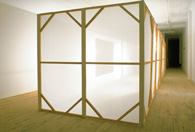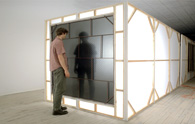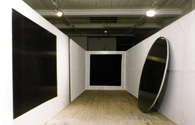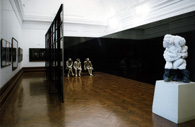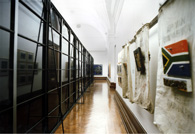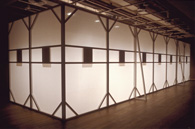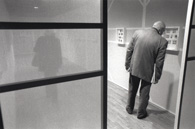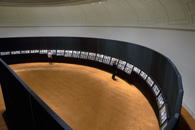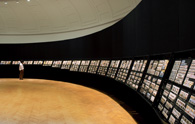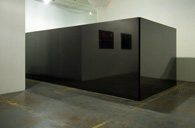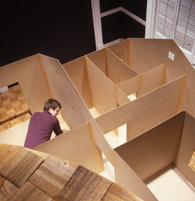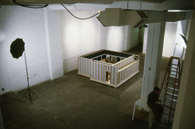
gallery, annex, washington, 2000

gallery, annex, washington, 2000
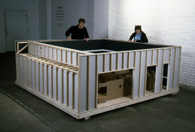
gallery, annex, washington, 2000

house, gallery 400, chicago, 1999
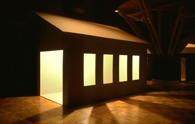
house, gallery 400, chicago, 1999
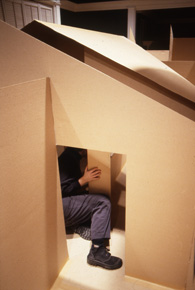 house, gallery 400, chicago, 1999 house, gallery 400, chicago, 1999
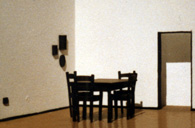
dining room, ica, johannesburg, 1993
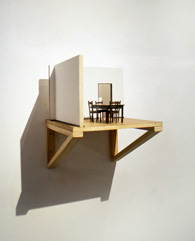
dining room, ica, johannesburg, 1993
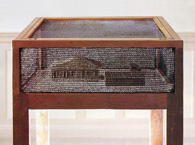
the collector, volkskas, pretoria, 1993
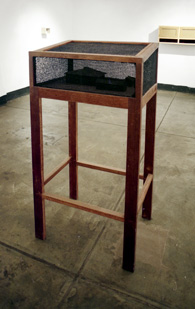 the collector, volkskas, pretoria, 1993 the collector, volkskas, pretoria, 1993
|
THE ROOM WITHIN A ROOM
by Siemon Allen
The display case was a device common to a number of my early works. Employed to isolate and present both manufactured and found objects, my interest developed out of a need to explore the power of shifting context. A set of Hardy Boys books or a pair of Doc Martens shoes, common items from different stages of my youth were presented as artworks. The act of displacing these non-precious items examined the value of such cultural icons and the information encoded in seemingly ordinary things. Vicarious adventures in the comic or detective stories and symbols of constructed identity in the coveted brand name products were explored through simple framing in a display box.
These issues of display and context were further explored in later work with the construction of rooms within rooms. I recall being particularly interested in Shakespeare’s use of the play within a play in Hamlet as a device to accuse his father’s murderer, and it was through this rather oblique influence that I was inspired to construct a gallery within a gallery. In Untitled (Richmond, VA) (1996), I built a simulated exhibition space within an existing gallery space—a faux gallery, if you like. The art works, woven videotape and film, were embedded in the walls. Disguising this information-carrying material as formal painting, for me, spoke to the notion of a covert function.
However, more critical to the work that followed was the fact that the woven panels were presented within a larger installation, the faux gallery. Like the encased books in The Hardy Boys (1993), the paintings in my simulated gallery were transformed into artifacts by this act. In La Jetée (1997) at the Second Johannesburg Biennale, the construction of the room within a room coexisted with and re-contextualized those art objects that formed part of the South African National Gallery collection. Surrounding and reflecting, the panels interfered with any direct reading of the artworks. Significantly, once the videotape was woven and manipulated as a raw material, the images and information originally recorded onto it remained encoded. Its original visual information was undivulged. The installation’s temporary relationship with the contemporary South African National Gallery collection pointed to a re-reading and critique of the collection through reflection and distortion. In a sense, one could say that these panels were ‘grafted’ onto the existing collection, forcing a new and awkward hybrid.
In Pictures & Words, I continued to use the device of a room within a room and returned to the use of icons from my youth, in this case Tintin comics. I displayed fragments of the comics within a constructed small gallery. Each ‘specimen’ was created with mass produced multiples, which included sources from my childhood comic collection, theory books, and newspapers. All had been physically cut up and then recombined.
The work owed much to the cutup method used as a strategy to break open language. However, the cutups in this case were, for me, less an effort to tap into the unconscious, than, in the spirit of detournement, a collision of seemingly incompatible texts—the comic and the theoretical. I set out to expose the political in popular humor and the humor in theory. The Tintin character was not only a childhood favorite, but also in many ways a kind of alter ego. Regarded critically, he was an adventurous little colonial sliding unscathed from adventure to adventure—‘the exotics’ a backdrop for his story.
For House (1999), a project realized through the Visiting Artists Program of the School of the Art Institute of Chicago and the University of Illinois at Chicago (UIC), I used fragments of blueprints from my parents' home in South Africa to build a half-scale, accessible cardboard model in the gallery space. Upon entry the viewer transformed into oversized trespasser—the structure was large enough that one could move from room to room but too small to allow any easy access. The building of the installation beginning from a position of uneasy nostalgia for my white, middle-class South African upbringing and ending in the contradictory position of a social critique of the residual effects of apartheid.
Gallery (2000) took the House installation from Chicago to the absurd. For this work at Signal 66 in Washington, I shrank down the scale of my parents' house further, but this time included a model of Gallery 400 where House had previously been shown. The installation like Russian nesting dolls consisted of the cardboard model of a house in South Africa; inside a model of a gallery in Chicago; presented in a gallery space in Washington.
The refinement of the gallery within a gallery concept reached an apex with the Stamp Collection (2001) installation at the Corcoran Museum in Washington. Here I explored the political history and shifting identity of South Africa through the collecting, cataloging and display of a comprehensive collection of postal stamps released from its formation in 1910 to the present. Presented within the framework of an architectural construction that referenced the display conventions of a history museum, these approximately 8000 stamps created a kind of timeline, with each individual specimen offering a view into South African history. The exhibition told the story of the changing face of South Africa, revealing how the country, over time, had chosen to represent itself both within its borders and internationally. It was a fragmented narration that spoke not only through what was shown but also through what was not.
For me, it was significant that the exhibition at this museum would correspond with the peak season for visitors to the ‘historical museums’ in Washington and would operate within the same didactic language set up by those institutions. This project was an ‘art exhibition’, but one that referenced – or indeed even simulated - an ‘historical display’. An exhibition that presented the stamps as art objects (for the stamps are in many ways images operating through visual pleasure) as well as one that presented an ‘image of South Africa’ in a manner that seemed educational but also somewhat oblique.” The museum itself and the geographic context of the site in this context were yet another ‘frame’ around the collection and the architectural installation.
Interestingly, the Corcoran Museum is located across the street from the White House, and is one of the many institutions that are often a part of the tour of Smithsonian Museums that line the green space between the Capital and the Washington Monument. As a museum of art, the Corcoran mounts contemporary exhibitions, but the weight of history is evident both in the presence of its ‘beaux arts’ architecture and the self-consciousness of the city’s layout of monuments in the surrounding area. An exhibition of stamps from South Africa—addressing that government’s ‘image of itself’—would seem to be particularly significant in such a political context.
from unpublished notes on the various projects
|

talk, goethe institute, washington, 1999

fence, goethe institute, washington, 1999
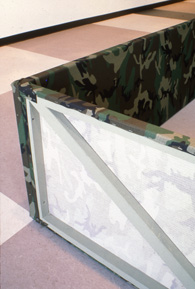
fence, goethe institute, washington, 1999
|
IMPORT, Goethe Institute, Washington, DC
Markus Wirthmann, Siemon Allen
Talk, 1999
Fence, 1999
[Broshure extract]
South African Artist, Siemon Allen, constructs both sculptural and sound installations to create works that deal with the nature of boundaries and shifting context. Here he continues these explorations with two new works. In Fence, camouflage fabric panels enclose a large portion of the upstairs gallery, inscribing a kind of ‘territory’ within the space. The reference to this familiar military print ‘reads’ protection, but its function is subverted. The pattern faces inward, and though it interfers with movement, it offers no covering. At two feet in height, it is a barrier easily crossed.
For Talk, installed in the darkened industrial downstairs gallery space, Allen combines cut up sounds from DC Talk radio programs with a large architecture structure. As a South African, Allen was especially interested in the relationship between public radio ‘open lines’ and the concept of ‘free speech’, Emitting from the vaguely perceived interior of an impenetrable black box, the isolated questions are presented with rather lengthy intervals of silence. It is work that confronts the viewer with frustrated entry and questions left unanswered.
text from the exhibition broshure for Import
a two person exhibition with Markus Withmann and Siemon Allen
published by Goethe Institute, Washington, DC, 1999
|
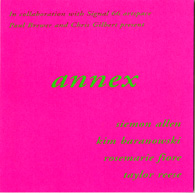
annex invite, signal 66, 2000
|
EXHIBITION HISTORY
VOLKSKAS ATELIER 1993
Merit Award
The Collector
University of Pretoria, Pretoria , South Africa
NSA
Siemon Allen, Greg Hayes, Greg Streak
The Hardy Boys and other display case pieces
August 3 - 14, 1993
NSA Gallery, Durban, South Africa
ICA
Siemon Allen, Greg Streak
Stamps, The Hardy Boys, Aeroplanes, Shirt & Boots and others
November 14 - December 5, 1993
Institute of Contempoarary Art, Johannesburg, South Africa
VITA 93
Stamps, Shirt & Boots
May 10 - July 24, 1994
Johannesburg Art Gallery, Johannesburg, South Africa
2ND JOHANNESBURG BIENNALE
curated by Okwui Enwezor
GRAFT
curated by Colin Richards
La jetée
October 12, 1997 - January 18, 1998
South African National Gallery, Cape Town, South Africa
VITA 98
curated by Natasha Fuller
Pictures & Words
1998
Sandton Civic Gallery, Johannesburg, South Africa
DRöMMAR OCH MOLN (DREAMS & CLOUDS)
curated by Ingemar Arnesson
Pictures & Words II
October 3, 1998 - January 10, 1999
Kulturhuset, Stockholm, Sweden
HOUSE
solo exhibition
Cry of My Birth residency curated by Valerie Cassel
January 10 - February 18, 2000
Gallery 400, Chicago, IL, USA
TRANSLATION/SEDUCTION/DISPLACEMENT
curated by Lauri Firstenberg & John Peffer
Screen
February 3 - April 1, 2000
White Box, New York, NY, USA
ANNEX
curated by Chris Gilbert & Paul Brewer
four person with
Siemon Allen, Kim Baranowski, Rosemarie Fiore, Taylor Reese
Gallery, 2000
March 10 - April 22, 2000
Signal 66, Washington DC, USA
STAMP COLLECTION - Imaging South Africa
Stamp Collection I
Curated by Paul Brewer
April - August, 2001
Hemicycle/Corcoran Museum, Washington, DC
|





 house, gallery 400, chicago, 1999
house, gallery 400, chicago, 1999


 the collector, volkskas, pretoria, 1993
the collector, volkskas, pretoria, 1993


